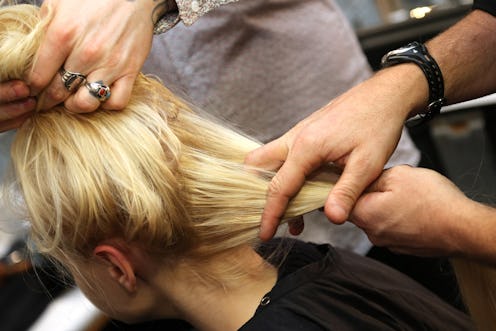In the '00s, when I moved to the NYC area, I used to hit the now-shuttered Patricia Field salon in the Village to get hair extensions. I would experiment with all different lengths, textures, and colors (Blue! Pink! Red!), which were mixed and braided into my long, straight, brown hair. The hair extension business is booming, thanks to celebs who get a lob one day and rock ass-length hair the next. The big question is where does hair extension hair come from?
When I used to get mine, they'd last for two months, then I'd get them tightened and filled, and try new shades. I loved it because I could mess around with different, not-found-in-nature colors without using damaging dyes. My stylist Alison once said, "You're hair is so pretty that it could be used as someone's else's extensions." That was years ago and I never thought twice about her comment...until now.
Who are the donors of non-synthetic AKA real human hair? It's not always virgin hair that has been voluntarily donated nor is it even something more nefarious, like locks that are cut and stolen. It could actually be dirty hair sourced from floors and hairbrushes!
Ick! Ack! Blergh! Insert any other comic book-like declaration punctuated by an exclamation point here.
Beauty website Byrdie offered a compelling, thorough, and well-researched report on where this hair comes from by talking to a pair of extension experts that have traveled the world and thus revealed some of the seedy underbelly of hair extensions.
Here's the basic intel: Indian hair is the most sought-after by the Western market because it is similar to Caucasian hair. Then there is the notion of fair trade, which refers to financial ethics, whereas the notion of ethically sourced hair pertains to hair that was obtained in a manner where both parties were in agreement and the hair is sold or donated accordingly.
Then there is temple hair, which has been offered by Indian men for religious purposes. When too many donations were made to the temple, excess hair would be burned. Temples eventually realized the value in the waste and began raising money by selling hair to the beauty industry for extensions, cycling the profit back into the community for good.
These types of hair are the best and most rare. What about the garden variety, every day hair extensions? That's where it gets more complicated since low quality hair is packaged as though it were high when it's anything but.
Non-remi, low-quality hair is mixed, with cuticles going in different directions and that leads to tangles. Most extensions are smooth and tangle-free, even though they are mixed. So how does that work? Well, that's the sort of gross part: that hair tends to come from the floor and old hairbrushes, then go through major processing at a plant to make it appear virgin. Byrdie's got the whole scoop, if you don't quite believe it.
While, yeah, that's pretty gross, the report indicates that kidnapping women to steal their hair or stealing hair from the deceased is relatively uncommon. Thank God for that!
The report is compelling enough to make you reconsider getting extensions or, at the very least, to educate and inform yourself to learn the source of the hair if and when you get hair extensions. I highly recommend the read.
Images: Giphy (4)
